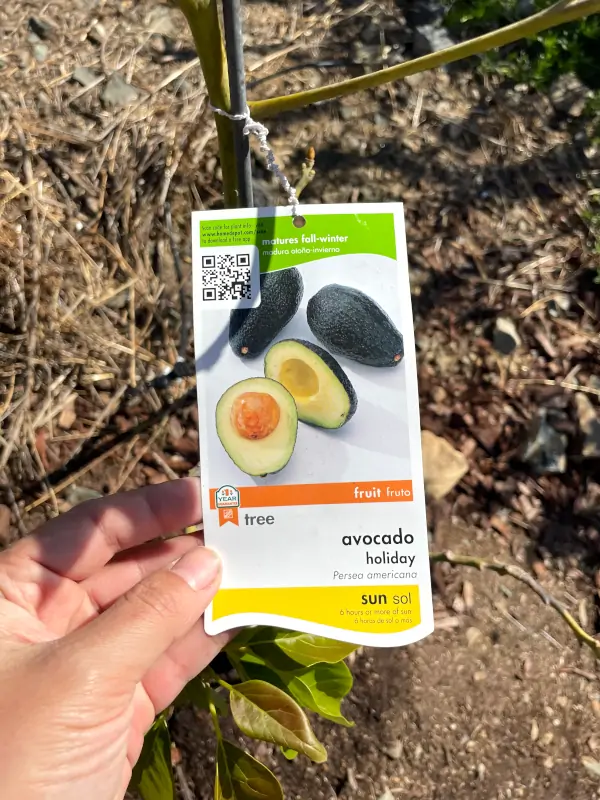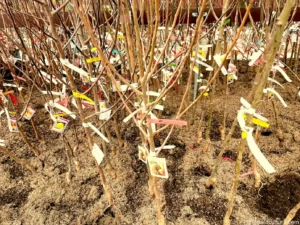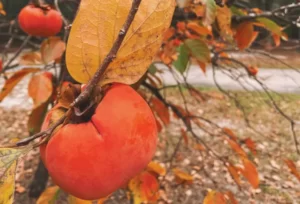Table of Contents
Choosing a Dwarf Avocado Tree
There are various factors to be considered when selecting a dwarf avocado tree instead of a standard size tree.
Advantages
(i) Less Space
The space requirement is the number one consideration for many. Standard avocado trees can grow extremely tall, usually between 30 to 60 feet, and about 20 to 30 feet wide.
Now this may not be an obstacle for you if you have ample space available or are able to dedicate the time and effort required to prune the tree regularly to keep it down to a more manageable size.
However, for many home growers who have less space available and prefer to grow smaller fruit trees with less effort, dwarf varieties tend to be more suitable.
(ii) Easy Harvest
A dwarf avocado tree will be easier to harvest as the fruit will be within reach without the need to climb on a ladder or utilize special equipment.
(iii) Adaptability
It’s not that dwarf avocado trees are naturally more adaptable to different growing conditions and environments. However, given their relatively small size, you will be able to take protective measures more easily, especially when you grow them in a less than ideal climate.
For instance, you can cover a small avocado tree with a frost blanket during cold weather or put on a shade cloth when there is an extreme heat wave.
Moreover, if you decide to grow an avocado tree in a container, which is more practical with dwarf avocado varieties, then you will be able to move it to another space that is more protected from the elements, such as close to a fence or even inside your home when necessary.
Disadvantages
(i) Lower Yield
This is easy to comprehend. Evidently, a smaller tree will produce less fruit. A standard avocado tree at maturity can yield hundreds of avocados per season. With a dwarf avocado tree, on the other hand, the average yield at maturity is much smaller, typically a few dozen avocados. That being said, as a home grower, you may be content with the smaller number of avocados you get from your tree as it may be all you need.
(ii) Average Taste
The major dwarf avocado tree varieties are not known for having superior taste. It’s not that they are mediocre or taste bad. They are still avocados of course. Nevertheless, they are not known for that rich, creamy taste you get from popular cultivars like Hass and Fuerte.
(iii) Limited Selection
There are many different types of avocado varieties available as standard size trees. Most tend to have a commercial origin.
This means they were developed to be grown in commercial orchards and for the fruit to be sold in stores. Consequently, high yield and larger tree sizes took priority.
Dwarf avocado trees do not usually meet the requirements of commercial growers. As a result, there has been less investment in this area, and there just aren’t many dwarf varieties to choose from.
When shopping for a dwarf avocado tree, you may find only one or two different varieties in your area. Also keep in mind your local nursery may not always have dwarf avocado trees on stock but when you contact them, they can usually let you know when the trees will become available or possibly special order them for you.
Neutral Factors
(i) Susceptibility
While many other types of dwarf fruit trees are known to be more susceptible to disease and tend to have less longevity due to weaker rootstock used for dwarfing, this is generally not the case with dwarf avocado trees. In this respect, they are usually no better or worse than standard size trees.
(ii) Fruiting
In general, dwarf fruit trees do tend to become productive sooner and bear young. With avocado trees, however, there is more variability and growing conditions are more important. While your tree could start to grow fruit within a couple of years, you also have to keep in mind that depending on the cultivar it can take over a year for the fruit to ripen.
Dwarf Avocado Varieties
The two most common dwarf avocado cultivars are the Wertz Avocado (sometimes spelled Wurtz), also known as Little Cado or Minicado, and the Holiday Avocado, also known as XX3.
The Wertz avocado is a true dwarf with an average height under 10ft.
Holiday is somewhat larger, 12ft tall at maturity with the potential for up to 16ft, but still diminutive compared to most standard size avocado trees.
Wertz Avocado / Little Cado / Minicado
Size
8 to 10 ft tall x 8 to 10 feet wide
Type
Wertz is a Type A avocado.
Fruit Shape
pear-shaped
Ripe Fruit Color
green
Self-Fruitful
Yes, it is self-fruitful.
A second tree is not required.
BUT: Fruit production will increase with a nearby Type B avocado tree.
Harvest Period (Southern California)
May – September
Cold Hardiness
19 degrees Fahrenheit (-7 degrees Celsius)
Additional Notes
The Wertz avocado goes back to 1948 when it was developed by Roy Wertz in Encinitas, California.
The exact origin is unclear but it is thought to be a Mexican Guatemalan hybrid.
Due to its small size, this avocado tree also came to be marketed as Little Cado and Minicado.



Holiday Avocado
Size
10 to 16 feet tall x 8 to 12 feet wide
Type
Holiday is a Type A avocado.
Fruit Shape
pear-shaped
Ripe Fruit Color
green
Self-Fruitful
Yes, it is self-fruitful.
A second tree is not required.
BUT: Fruit production will increase with a nearby Type B avocado tree.
Harvest Period (Southern California)
September – December
Cold Hardiness
30 degrees Fahrenheit (-1 degree Celsius)
Additional Notes
The Holiday avocado is a cultivar that was developed at the University of California at Riverside. Its official name is XX3, but it was later marketed as Holiday because the fruit tended to ripen between Labor Day and Christmas/New Year’s, i.e. from September through December.



Other Dwarf Avocado Varieties
If you are looking for other types of dwarf avocado trees, you will be disappointed.
There may be dwarf varieties other than Wertz and Holiday, but if that’s the case, then they are not well known and there must be good reasons for their obscurity.
More likely than not, if you do happen to come across another avocado tree that appears to be a dwarf, then something else could be happening.
The first possibility is that the tree is actually a Wertz or Holiday but simply marketed under a different name. Sometimes Wertz / Little Cado is simply given the more generic designation Dwarf Avocado Hybrid.
The second possibility is that the tree you are dealing with is not actually a true dwarf avocado tree. This is more likely due to a misunderstanding involving references to the growing habit of the tree, the size of the fruit, or even the minimum size at maturity.
The popular GEM avocado tree, for instance, is well known for its ‘compact’ growth habit relative to Hass but the mature tree size is still over 25 feet.
Other times the ‘small’ descriptor is in reference to the fruit itself. Different types of avocado trees produce fruits of different average sizes. For example, Puebla avocados tend to be smaller but that does not mean that the trees that they grow on are smaller as well.
It’s also quite common for product labels to give a range of sizes for mature trees. For example, this label for a Pinkerton avocado shows a range starting at 15ft. The mature tree can be kept small at that size but it is likely to grow much tall and it is certainly not a dwarf variety.

How to Care for Dwarf Avocado Trees
In many respects, planting instructions and regular care of dwarf avocado trees resemble what you’d do for standard avocado trees.
Planting
When you buy an avocado tree from a nursery, it will usually come in a container along with a product label that includes basic instructions.
The planting hole should be twice as deep and wide as the container. When you remove the root ball from the container and put it in the ground, the top should be at least even with the ground surface.
Avocado trees are very sensitive to overwatering. For this reason, you may want to consider planting the tree a couple of inches above ground level to start and add some soil around it. As the tree grows, it is likely to settle down a bit.
It is also advised to water the planting hole before and after you put the tree in. When you remove the tree from the container and plant it in the ground, there will be some transplant shock initially, so you want to make sure to give it as much energy as possible.
On that note, it is is also important to choose the right timing when planting the tree. Avoid planting the avocado tree during extreme heat waves or cold weather so as not to stress the tree even more.
Soil
The conventional advice is to plant fruit trees in a 50-50 mix of amended soil, which you can buy at the nursery or garden center, and the native soil that was already present in the hole you dug.
However, in recent years, there has been a shift away from soil amendments. This is to ensure that the tree roots adapt to the natural soil conditions and extend beyond the original planting hole, which ultimately results in a stronger root system and a healthier tree.
Otherwise, if the planting hole was filled with amendments, a couple of things would happen. First of all, the roots would not be be under pressure to expand and could self-restrict to the ‘good’ soil in the planting hole, similar to a container, which can then also cause a root-bound problem. The less extensive root system then renders the tree more vulnerable to adverse conditions. Secondly, the amended soil, which consists mainly of compost and other organic substances, would be likely to break down over time. Essentially, the amended soil would slowly disappear and you would then have to refill the hole with additional soil.
Ultimately, unless you know for a fact that there are serious deficiencies in your soil, which is unlikely in most situations, you should not have to add any soil amendments to the planting hole. Similar to natural processes, any amendments or compost should be added on top of the soil only and over a wider area.
You may be wondering if there is still a need to have a planting hole that is deeper and wider than the root ball of the tree that you are planting, given that you are refilling the hole with the same native soil you dug out anyway. Yes, that is still necessary. To get the tree off to a good start, you want to make sure to break up the soil around it. It will be easier for the roots to get through the soil when it’s softened up.
Mulch
As with any fruit tree, it is recommended to add a 2 to 3 inch layer of mulch to help reduce need for supplemental irrigation.
Just make sure to keep the mulch away from the trunk of the tree to avoid excess moisture and risk of root rot.
The mulch will also break down over time and add valuable nutrients to the soil around the avocado tree.
This is also true for the avocado leaves that may drop from the tree over time. The leaves represent somewhat of a natural mulch barrier, so you should leave them where they are.
Watering
Initially, when the tree is still very small and getting newly established, you will need to water often, two to three times a week, and even more so if you planted during very hot weather.
The avocado leaves will signal to you when the tree is doing well or struggling. Ideally, the leaves should look firm with somewhat of an upward cupping appearance. (Note that this is the opposite of citrus leaves, which cup upward when the tree is in need of more water.) If the leaves look droopy, the tree likely requires more water.
Over time, you can decrease the frequency with which you water the tree. After a year or so, you may need to water only once per week. However, as the tree grows, the watering times will also need to be longer, so the amount of water you give the tree is going to be more, even if it’s less often.
Fertilizing
Avocados are evergreen trees, though their growth does slow down in colder months. You should be fertilizing the tree more actively during the spring and summer. Preferably use an organic fertilizer to avoid harming the tree roots. In the past, it was common to recommend fertilizing fruit trees just a couple of times a year. This may be more practical for some growers to implement but the tree will benefit even more if you can fertilize it with smaller amounts at more frequent intervals during the growing season.
Pruning
There really should not be much of a need to prune the tree, given that it is dwarf variety to begin with. Avocado trees are evergreen. They are not deciduous fruit trees and there is no need to remove leaves or prune branches to attain a particular shape. The tree needs all its leaves as a source of energy. Moreover, if branches are exposed without a canopy of leaves to cover them, they may get sunburnt and suffer damage in hot weather.
Alternatives
While opting for a dwarf avocado tree certainly has its benefits, you may find that some of the alternatives may work better for you depending on your priorities.
Growing Standard Avocado Trees in Containers
By choosing to grow a standard avocado tree in a container, you can constrain its ability to grow tall and wide.
You may be wondering if standard avocado trees will still bear fruit if they are grown in a container instead of in ground. And the answer to that is an emphatic yes. When you are shopping for an avocado tree at a nursery, pretty much all the trees you will see are planted in containers and the more mature ones, which also happen to be larger in size and much more expensive, may even carry some fruit. That being said, the yield will also be more limited, though that is expected.
Another downside with growing standard avocado trees in containers is that they will still require considerable care and attention. You will need to water the tree more frequently, perhaps even daily in hot weather. Additionally, you will have to do more pruning and as the tree grows larger, you may need to upsize to a bigger container.
The more challenging growing conditions in a container can also harm the tree. The average lifespan of a container grown tree is much shorter than when it is planted in ground. That is also something you will have to keep in mind. You may only have the the avocado tree for a few years.
Pruning Standard Avocado Trees
This is no doubt the most popular method for keeping avocado trees down to a manageable size. You can keep a standard tree down to a size of about 10 to 15 feet by committing to a regular pruning schedule once or twice a year. That does not sound like much of a challenge but it is nevertheless a commitment you will have to make and adhere to over many years. If you do not believe this is practical, then you will still be better off with a dwarf avocado tree to begin with.


![Read more about the article Anna Apple – Profile and Review [Photos]](https://orchardculture.com/wp-content/uploads/2023/08/anna-apple-branch-300x234.webp)

